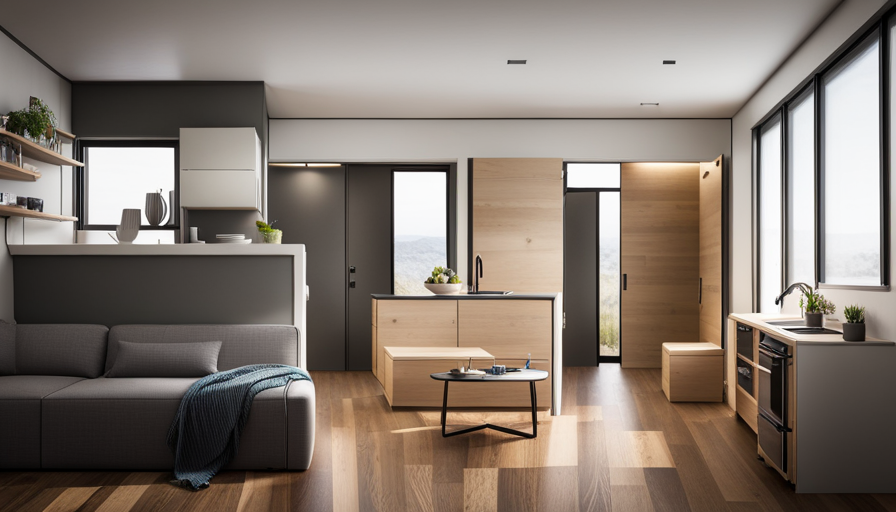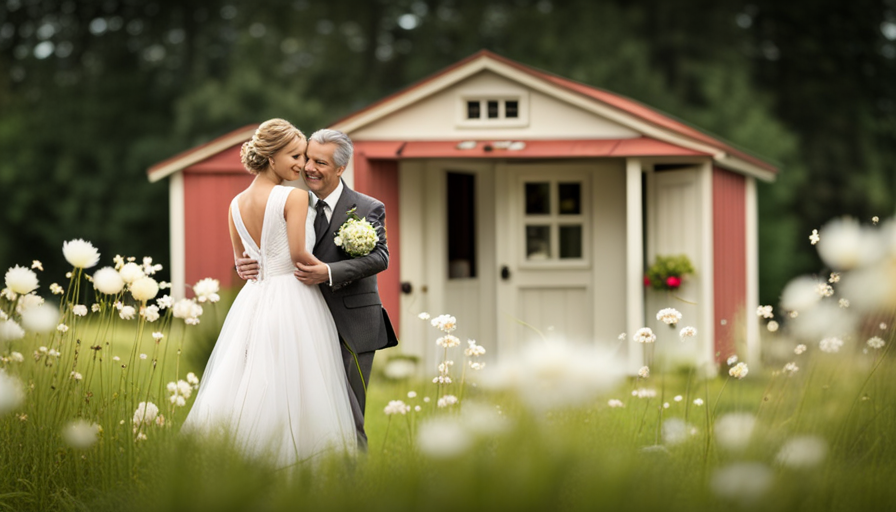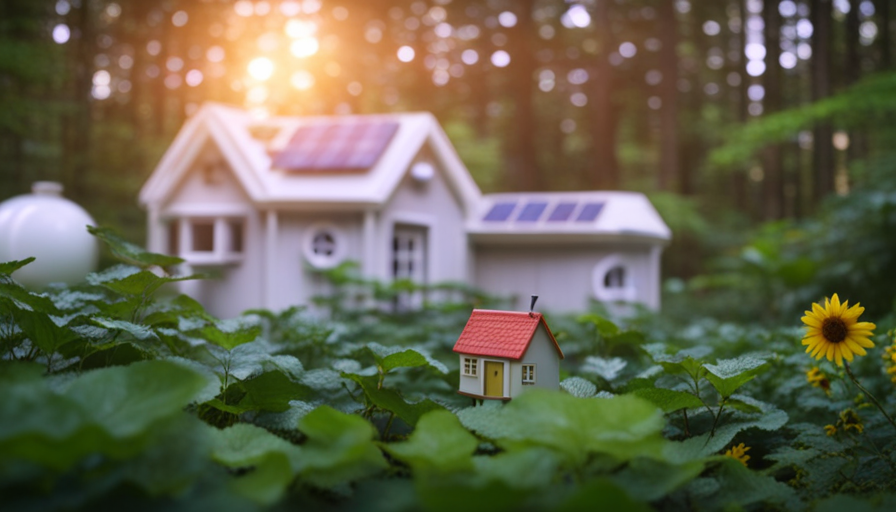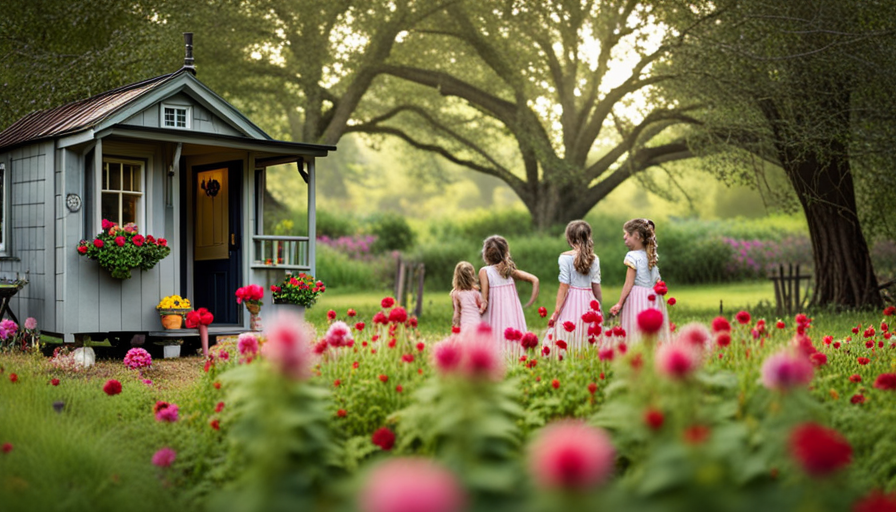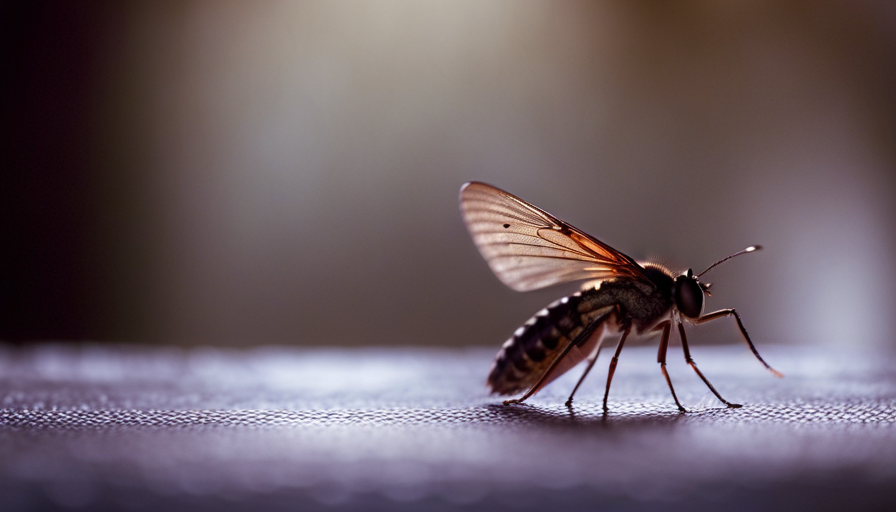Selling a small house may appear challenging, but with the appropriate knowledge and strategy, it can turn into a satisfying experience. Welcome to a realm where smart choices result in a fantastic outcome! If you’re prepared to say goodbye to your snug home and start a new journey, I’m here to assist you every step of the way.
From determining the market value to finalizing the sale and everything in between, I’ll share my expertise to ensure a seamless transaction. Get ready to navigate the real estate realm and reap the rewards of your tiny treasure.
With a pinch of preparation, a dash of determination, and a sprinkle of savvy, you’ll be celebrating a successful sale in no time. So gather your thoughts, tighten your belt, and let’s embark on this exciting journey together! Let the selling commence!
Key Takeaways
- Research market value and comparable sales
- Prepare and stage the house for sale
- Utilize effective marketing strategies, including social media and online platforms
- Ensure legal requirements are met and handle paperwork accurately
Determine the Market Value of Your Tiny House
To determine the market value of your tiny house, you’ll need to imagine yourself as a potential buyer, mentally walking through the cozy interior and picturing the allure it holds for minimalist living enthusiasts.
Start by determining the market demand for tiny houses in your area. Researching comparable sales will give you an idea of what other tiny houses are selling for and what features and amenities are desirable to buyers. Take note of the size, location, and condition of these homes to help you assess the value of your own tiny house.
By understanding the market demand and researching comparable sales, you’ll be able to price your tiny house competitively and attract potential buyers. Now that you have a good grasp of the market value, let’s move on to preparing your tiny house for sale.
Prepare Your Tiny House for Sale
Before showcasing your cozy abode to potential buyers, make sure every corner is meticulously organized and adorned with charming decor that invites them to envision their future dream home. Staging your tiny house is crucial to attract buyers and make a lasting impression.
Here are some staging tips to help you prepare your tiny house for sale:
- Declutter and remove personal items to create a clean and neutral space.
- Use multipurpose furniture to maximize the functionality of small spaces.
- Emphasize natural light by opening curtains and using light-colored furnishings.
To effectively market your tiny house, consider these strategies:
- Utilize social media platforms to reach a wide audience.
- Highlight unique features and advantages of living in a tiny house.
- Offer virtual tours or video walkthroughs for potential buyers unable to visit in person.
By following these staging tips and marketing strategies, you can create an enticing environment that will captivate buyers and increase your chances of a successful sale.
Now, let’s move on to the next section about how to take high-quality photos and create a compelling listing.
Take High-Quality Photos and Create a Compelling Listing
Capture the essence of your charming abode by taking high-quality photos and crafting an enticing listing that will captivate potential buyers and leave a lasting impression. When creating appealing descriptions for your tiny house, highlight its unique features and emphasize the benefits of living in a compact yet functional space. Utilize social media platforms like Instagram and Facebook to reach a wider audience and showcase your tiny house’s beauty. Share stunning photos, interesting facts, and stories that will make buyers envision themselves living happily in your cozy home. Additionally, consider incorporating a 3 column and 3-row table in your listing to provide a quick overview of the key features, dimensions, and pricing of your tiny house. Now that you have created an appealing listing, it’s time to move on to the next step of advertising your tiny house.
Advertise Your Tiny House
Spread the word and let potential buyers feast their eyes on your tiny slice of paradise by showcasing your compact haven in creative and captivating ways.
Start by advertising your tiny house rental on popular platforms such as Airbnb, VRBO, and Tiny House Listings. Craft a compelling listing that highlights the unique features and benefits of your tiny house, and include high-quality photos that showcase every nook and cranny.
Don’t forget to mention any financing options available for potential buyers, as this can be a major selling point.
Additionally, utilize social media platforms to reach a wider audience and engage with potential buyers. Respond promptly to inquiries and be accommodating to schedule viewings and answer any questions.
By being responsive and accommodating, you will increase your chances of finding the perfect buyer for your tiny house.
Be Responsive and Accommodating to Potential Buyers
When potential buyers reach out with inquiries or schedule viewings, I make it a priority to respond promptly and accommodate their needs. Responsive communication is essential in building trust and keeping potential buyers engaged throughout the sales process. To ensure a positive experience, I offer flexible scheduling options to accommodate their busy lives.
Here are some ways I strive to be responsive and accommodating:
- Promptly answer phone calls, emails, and messages to show that I value their interest.
- Provide detailed information about the tiny house, answering any questions they may have.
- Offer virtual tours or video calls for those unable to visit in person.
- Be flexible with viewing times, including evenings and weekends.
- Listen to their specific requirements and tailor the viewing experience accordingly.
By being responsive and accommodating, I aim to make the buying process as smooth and convenient as possible.
In the next section, I will discuss how to effectively show your tiny house.
Show Your Tiny House
Don’t miss the opportunity to showcase the incredible charm and unique features of your pint-sized abode. When it comes to selling a tiny house, presentation is key. By creating an inviting and well-designed space, you can attract potential buyers and stand out from the competition. Showcasing the design of your tiny house is essential in capturing the interest of buyers who are looking for a unique and efficient living experience.
To showcase your tiny house effectively, consider creating a three-column, three-row table that highlights its most appealing features. Include details such as square footage, number of bedrooms, and special amenities. This visual representation will draw the audience in and keep them interested in learning more about your property.
By presenting your tiny house in an attractive and informative manner, you increase your chances of attracting serious buyers. Now that you’ve successfully showcased your tiny house, it’s time to move on to the next step: negotiating and finalizing the sale.
Negotiate and Finalize the Sale
When it comes to negotiating and finalizing the sale of a tiny house, there are three key points to keep in mind.
First, it’s important to set a fair price for your tiny house, taking into account factors such as its size, condition, and location.
Second, be open to negotiation and willing to compromise in order to reach an agreement that satisfies both you and the buyer.
Finally, ensure that all legal requirements are met, such as transferring the title and completing any necessary paperwork, to protect both parties involved in the sale.
Set a Fair Price
To ensure a successful sale, it’s crucial that you establish a fair price for your tiny house. Here are three key factors to consider when determining the value of your property:
-
Location: The area where your tiny house is located plays a significant role in its pricing. Consider the demand for tiny houses in that particular region and compare it to similar listings to get an idea of the market value.
-
Features and amenities: Highlight the unique features and amenities your tiny house offers. These could include sustainable materials, energy-efficient appliances, or innovative storage solutions. Emphasize these selling points to justify a higher price.
-
Marketing strategies: Invest time and effort into effective marketing strategies to attract potential buyers. Utilize online platforms, social media, and local real estate listings to showcase your tiny house’s best features and reach a wider audience.
By setting a fair price and implementing effective marketing strategies, you can maximize your chances of selling your tiny house successfully. Be open to negotiation to ensure a mutually beneficial agreement with potential buyers.
Be Open to Negotiation
Being open to negotiation can lead to a mutually beneficial agreement with potential buyers, increasing the chances of a successful sale. Openness to compromise and flexibility in negotiations are key when selling a tiny house. By being willing to discuss and adjust the terms, you show that you value the buyer’s needs and are invested in finding a solution that works for both parties. To grab the attention of potential buyers, consider using a table that highlights the main features and benefits of your tiny house. This visual representation can showcase the unique aspects of your property and make it stand out from the competition. Additionally, it helps buyers compare your tiny house to others they may be considering. By being open to negotiation and providing clear information, you can create a positive buying experience. Transitioning into the next section, it is important to ensure all legal requirements are met to protect both the buyer and the seller.
Ensure All Legal Requirements are Met
Make sure you meet all legal requirements to protect yourself and the buyer. Meeting legal requirements is crucial when selling a tiny house. Before listing your property, take the time to research zoning regulations in your area.
Ensure that your tiny house is built according to the local building codes and obtain any necessary permits. Additionally, check if there are any specific regulations or restrictions related to tiny houses in your community.
By complying with all legal requirements, you can avoid potential fines or complications during the sales process. Once you have met these obligations, you can confidently move forward with handling the paperwork and transfer of ownership, ensuring a smooth and successful transaction.
Handle the Paperwork and Transfer of Ownership
Navigating the paperwork and transferring ownership of a tiny house can feel like untangling a web of red tape, but with a little persistence and organization, it becomes a manageable task.
When it comes to handling the paperwork, it’s important to gather all necessary documents, such as the title, bill of sale, and any permits or certificates. Ensure that the information on these documents is accurate and up to date.
Next, contact your local government office or Department of Motor Vehicles to understand the specific requirements and processes for transferring ownership of a tiny house in your area. This may include completing transfer forms, paying any applicable fees, and providing proof of insurance.
By following these steps, you can confidently handle the paperwork and smoothly transfer ownership of your tiny house.
Now, let’s move on to preparing for the transition to a new home.
Prepare for Moving Out and Transitioning to a New Home
When preparing to move out of a tiny house and transition to a new home, it’s crucial to organize your belongings efficiently. By decluttering and categorizing your items, you can streamline the moving process and ensure that nothing gets lost or damaged along the way.
Additionally, planning the logistics of the move, such as hiring movers or renting a truck, will help alleviate stress and ensure a smooth transition.
Once you arrive at your new living arrangements, take the time to settle in and make it feel like home by unpacking, arranging furniture, and familiarizing yourself with the space.
Organize Your Belongings
Decluttering your possessions will help you create a cozy and stress-free living space in your tiny house. To maximize space, it’s important to only keep the items that are essential and bring you joy.
Start by sorting your belongings into categories and decide what to keep, donate, or sell. Utilize clever storage solutions like under-bed storage bins or wall-mounted shelves to make the most of every inch. Use vertical space wisely and invest in multi-purpose furniture that can serve multiple functions.
When decluttering, remember to be ruthless and let go of items that no longer serve a purpose in your life. By organizing your belongings, you’ll create a harmonious environment in your tiny house.
Now that your possessions are in order, let’s move on to planning the logistics of moving.
Plan the Logistics of Moving
Once you’ve successfully organized your belongings and created a cozy living space, it’s time to strategize the logistics of your upcoming move. Moving a tiny house presents its own unique set of challenges, but with proper planning, it can be a smooth process. Here are some key points to consider:
-
Size Matters: Ensure that the moving company you choose is experienced in handling tiny houses. They should have the necessary equipment and expertise to transport your home safely.
-
Permits and Regulations: Research the specific permits and regulations in your area for moving a tiny house. Make sure you comply with all legal requirements to avoid any issues during the move.
-
Insurance Coverage: Verify that the moving company has adequate insurance coverage to protect your tiny house in case of any damage during transit.
Finding a reliable moving company that understands the intricacies of moving a tiny house is crucial. Once you’ve sorted out the logistics, you’ll be ready to settle into your new living arrangements seamlessly.
Settle into Your New Living Arrangements
After successfully moving my tiny house to its new location, it was time to settle in and adjust to my new living arrangements.
Although the space was smaller than what I was used to, I quickly realized that with a little creativity and organization, I could make it feel just like home. I started by carefully arranging my furniture to maximize the use of space and create a cozy atmosphere.
I added personal touches such as photos, artwork, and plants to make the space feel more inviting. It took some time to get used to the smaller scale, but soon enough, I found myself embracing the simplicity and efficiency of tiny living.
As I settled into my new home, I couldn’t help but feel a sense of accomplishment and satisfaction. Now, it was time to celebrate my successful sale and share my experience with others.
Celebrate Your Successful Sale and Share Your Experience
Don’t forget to take a moment to savor the exhilarating feeling of closing the deal on your tiny house sale and share your incredible experience with others!
Selling a tiny house is no small feat, and celebrating your success is just as important as the sale itself.
This is the perfect opportunity to inspire others who may be considering selling their own tiny house. Sharing success stories and offering tips for celebrating can go a long way in motivating and encouraging others in their journey.
You can share your experience through social media platforms, online forums, or even by hosting a small gathering for friends and family.
Remember, celebrating your successful sale not only allows you to relish in your accomplishment but also provides a chance to inspire and support others in their tiny house selling endeavors.
Frequently Asked Questions
How long does it typically take to sell a tiny house?
Typically, selling a tiny house takes around 3-6 months, but it’s essential to develop effective pricing strategies to expedite the process.
Let me share an anecdote that illustrates this point. Just like a well-stocked fishing pond attracts more fish, pricing your tiny house competitively will attract more potential buyers.
By strategically setting a price that aligns with market trends and comparable listings, you can reel in interested buyers faster and secure a quick sale.
Are there any specific legal requirements or permits needed to sell a tiny house?
There are specific legal requirements and building permits that need to be considered when selling a tiny house. These requirements vary depending on the location and local regulations.
It’s important to research and understand the legal obligations in your area to ensure a smooth and legal transaction. Building permits may be required to ensure the tiny house meets safety and zoning standards.
Consulting with a real estate professional or a legal expert can provide valuable guidance throughout the selling process.
What are some common challenges or obstacles that people face when selling a tiny house?
Common challenges people face when selling a tiny house include finding the right target market, effectively marketing the unique features of the house, and navigating legal and zoning restrictions.
To overcome these obstacles, it’s crucial to develop creative marketing strategies that highlight the advantages of tiny living, such as affordability, eco-friendliness, and minimalism.
Utilizing social media platforms, hosting open houses, and networking with real estate agents who specialize in tiny homes can also help attract potential buyers.
How can I effectively market my tiny house to attract potential buyers?
To effectively market my tiny house and attract potential buyers, I’d implement a range of effective marketing strategies.
Firstly, I’d identify my target audience, such as eco-conscious individuals or minimalist enthusiasts, to tailor my marketing efforts accordingly.
Next, I’d create a compelling listing with high-quality photos and detailed descriptions of the unique features and benefits of my tiny house.
Additionally, I’d utilize social media platforms, online classifieds, and local real estate agents to reach a wider audience and maximize visibility.
Are there any potential tax implications or considerations when selling a tiny house?
Selling a tiny house can have potential tax implications. It’s important to consider capital gains tax if you’ve owned the house for less than a year.
Additionally, financing options can also impact the tax situation. For example, if you offer seller financing, you may need to report the interest income.
Consult a tax professional to ensure compliance with all tax laws and to explore any potential deductions or credits that could benefit you during the sale process.
Conclusion
Selling a tiny house is a thrilling journey, full of careful planning and strategic moves. By determining the market value, preparing your home for sale, and creating an enticing listing, you can attract potential buyers.
Advertise your tiny house effectively and be responsive to inquiries, negotiating a fair deal and finalizing the sale. Handling paperwork and transferring ownership smoothly is crucial.
As you transition to a new home, celebrate your successful sale and share your experience with others, spreading the joy of tiny living!
Hi, I’m Emma. I’m the Editor in Chief of Tiny House 43, a blog all about tiny houses. While tree houses are often associated with childhood, they can be the perfect adult retreat. They offer a cozy space to relax and unwind, surrounded by nature. And since they’re typically built on stilts or raised platforms, they offer stunning views that traditional homes simply can’t match. If you’re looking for a unique and romantic getaway, a tree house tiny house might just be the perfect option.
